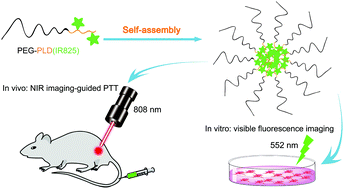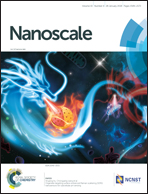Turning double hydrophilic into amphiphilic: IR825-conjugated polymeric nanomicelles for near-infrared fluorescence imaging-guided photothermal cancer therapy†
Abstract
Developing biocompatible and photodegradable photothermal agents (PTAs) holds great promise for potential clinical applications in photothermal cancer therapy. Herein, a new PTA was innovatively constructed by conjugating the hydrophobic near-infrared (NIR) heptamethine cyanine molecule IR825-NH2 with a double hydrophilic block copolymer methoxypoly(ethylene glycol)5k-block-poly(L-aspartic acid sodium salt)10 (abbreviated as PEG-PLD) via amine-carboxyl reaction. The as-designed PEG-PLD(IR825) was amphiphilic and could self-assemble into polymeric nanomicelles in aqueous solutions. Benefiting from the chemical conjugation strategy, PEG-PLD(IR825) nanomicelles realized a considerably high drug loading rate (∼21.0%) and substantially avoided the premature release of IR825 during systemic circulation. Confocal imaging revealed that the nanomicelles mainly located at mitochondria and endoplasmic reticulum after cellular internalization. In vitro photothermal therapy demonstrated the excellent cancer killing efficiency of PEG-PLD(IR825) nanomicelles due to their high light-to-heat conversion efficiency upon NIR laser irradiation. In addition, PEG-PLD(IR825) nanomicelles showed polarity-sensitive fluorescence at ∼610 nm (under 552 nm excitation) and 830 nm (under 780 nm excitation), which was especially useful for both in vitro visible fluorescence imaging and in vivo near-infrared fluorescence imaging-guided photothermal therapy (PTT). At the in vivo level, PEG-PLD(IR825) nanomicelles exhibited an excellent tumor-homing ability and a long retention time in tumor tissues as evidenced by the in vivo fluorescence imaging results. The desirable properties of PEG-PLD(IR825) nanomicelles ensured their effective tumor ablation during PTT treatment. More importantly, the PEG-PLD(IR825) nanomicelles underwent degradation after laser irradiation, which ensured their post-treatment biosafety. Therefore, the nanomicelles are promising to serve as an efficient and safe PTA for imaging-guided photothermal cancer therapy.



 Please wait while we load your content...
Please wait while we load your content...